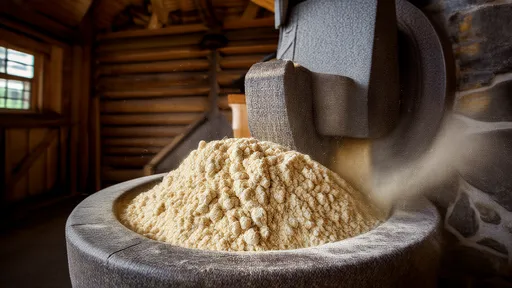The world of fermented foods is a fascinating intersection of microbiology, chemistry, and culinary tradition. Among these, kimchi stands out not only for its bold flavors but also for the intricate biochemical processes that transform raw vegetables into a probiotic-rich delicacy. At the heart of this transformation lies a phenomenon known as acetic acid penetration, which creates a dynamic pH gradient during fermentation. This process is far more than a simple souring of cabbage—it's a carefully orchestrated dance between microbial communities and their chemical environment.
When kimchi fermentation begins, lactic acid bacteria (LAB) naturally present on the vegetables start metabolizing sugars. The initial stages are dominated by Leuconostoc species, which produce carbon dioxide and various organic acids, including acetic acid. What makes this process remarkable is how acetic acid—a relatively weak organic acid—manages to penetrate vegetable tissues and create a pH gradient that fundamentally changes the fermentation environment. Unlike stronger acids that might immediately acidify the entire system, acetic acid's gradual penetration allows for sequential microbial succession, crucial for developing kimchi's complex flavor profile.
The pH gradient phenomenon in kimchi fermentation represents a beautiful example of spatial chemistry in food systems. As acetic acid molecules diffuse through the cabbage leaves, they create microenvironments with varying acidity levels. Near the surface where oxygen is more available, acetic acid bacteria (AAB) can thrive, producing more acetic acid from ethanol. Deeper within the vegetable tissue, anaerobic conditions favor different LAB strains that prefer slightly higher pH. This gradient isn't static—it evolves throughout fermentation, creating what microbiologists call temporal-spatial heterogeneity.
Traditional kimchi makers have intuitively understood this process for generations, even if they didn't know the molecular details. The practice of salting cabbage before fermentation isn't just about drawing out water—it alters cell membrane permeability, facilitating acetic acid penetration. Modern scientific studies using pH-sensitive fluorescent dyes have visually demonstrated how this pH gradient develops, showing acid fronts moving inward from cut surfaces and leaf edges. These gradients typically range from pH 4.0-4.5 at the surface to pH 5.5-6.0 in inner tissues during early fermentation stages.
Temperature plays a crucial role in modulating acetic acid penetration. In colder fermentations (around 4°C), the process slows dramatically, allowing for more gradual acid penetration and microbial succession. This explains why winter kimchi (kimjang kimchi) develops deeper, more complex flavors compared to quick-fermented summer versions. The cold temperature essentially stretches out the pH gradient's existence, giving different microbial communities more time to contribute their unique metabolic byproducts to the final flavor matrix.
The implications of understanding acetic acid penetration extend beyond kimchi. This knowledge could revolutionize controlled fermentation processes for other vegetables, potentially creating new categories of fermented foods with tailored flavor profiles and enhanced probiotic content. Some researchers are experimenting with pre-acidification techniques or acetic acid-containing starter cultures to manipulate the pH gradient intentionally. Such approaches might allow food scientists to emphasize certain flavor compounds or accelerate fermentation while maintaining quality.
From a food safety perspective, the pH gradient presents both challenges and safeguards. Pathogenic bacteria struggle to survive in the acidic outer layers, but might persist temporarily in higher pH inner zones during early fermentation. This explains why proper salt concentration and fermentation time are critical—they ensure the pH gradient eventually homogenizes at a safely acidic level (below pH 4.6). Modern kimchi producers monitor this carefully, often using mathematical models to predict acid penetration rates based on vegetable thickness and brine composition.
Recent studies have revealed surprising nuances about acetic acid's role. While it was long considered merely a transitional metabolite, we now know it serves as a chemical messenger between microbial communities. Certain LAB species actually slow their lactic acid production when acetic acid concentrations reach threshold levels, preventing over-acidification that would kill the microbial ecosystem. This quorum-sensing mechanism helps maintain biodiversity throughout fermentation—a key factor in kimchi's health benefits and flavor complexity.
The culinary implications of pH gradient management are profound. Chefs at avant-garde Korean restaurants have begun experimenting with gradient fermentation techniques, creating kimchi where different layers deliberately maintain distinct acidity levels and flavor profiles. One innovative approach involves packing jars with alternating layers of pre-acidified and fresh cabbage, resulting in a single batch containing multiple taste experiences—from bright and tangy near the surface to subtly sweet and umami-rich in the center.
As research continues, scientists are discovering that the acetic acid penetration phenomenon in kimchi may have parallels in other traditional fermented foods worldwide, from German sauerkraut to Ethiopian injera batter. This suggests we might be looking at a universal principle in vegetable fermentation—one that our ancestors harnessed empirically, and which modern science is now beginning to decode. The humble pH gradient, it turns out, is anything but simple—it's a dynamic system that bridges microbiology, food chemistry, and culinary artistry.
The art of baking a perfect cake relies heavily on understanding the science behind its structure. Among the many factors that contribute to a cake's texture, the uniformity of air pockets within the cake crumb stands out as a critical element. This characteristic is largely influenced by the foaming properties of proteins in the batter, particularly those found in eggs. The way proteins trap and stabilize air bubbles during mixing directly impacts the final product's lightness, tenderness, and overall mouthfeel.
The world of sensory evaluation is as intricate as it is fascinating, particularly when it comes to understanding how we perceive flavors and aromas. Among the myriad of compounds that contribute to our sensory experiences, vanillin—the primary component of vanilla extract—stands out for its widespread use and complex interaction with our senses. The concept of odor threshold plays a pivotal role in determining how much of this compound is needed for it to be detectable, and it varies significantly depending on the medium in which it is presented.
The world of chili peppers is as diverse as it is fiery, with each variety packing its own unique punch. At the heart of understanding this heat lies the Scoville Scale, a measurement that quantifies the spiciness of peppers. Developed by Wilbur Scoville in 1912, this scale remains the gold standard for gauging the capsaicin content—the compound responsible for that burning sensation—in different peppers. From the mild bell pepper to the mind-numbing Carolina Reaper, the Scoville Scale offers a fascinating glimpse into the spectrum of heat that chili enthusiasts chase.
The culinary world has long celebrated the magic that happens when certain ingredients come together, creating flavors greater than the sum of their parts. One such pairing—chicken broth and mushrooms—exemplifies the scientific and gastronomic phenomenon known as umami synergy. This dynamic duo has been a staple in kitchens across cultures, from French consommé to Japanese ramen, and its power lies in the way their compounds interact to amplify savory depth.
The world of fermented foods is a fascinating intersection of microbiology, chemistry, and culinary tradition. Among these, kimchi stands out not only for its bold flavors but also for the intricate biochemical processes that transform raw vegetables into a probiotic-rich delicacy. At the heart of this transformation lies a phenomenon known as acetic acid penetration, which creates a dynamic pH gradient during fermentation. This process is far more than a simple souring of cabbage—it's a carefully orchestrated dance between microbial communities and their chemical environment.
The turbidity of fruit juice, often perceived as a mark of freshness and natural quality, is primarily governed by the suspension mechanisms of pulp particles. These tiny fragments of fruit flesh, ranging from cellular debris to larger fibrous clusters, create the characteristic cloudiness that consumers associate with premium products. Behind this seemingly simple phenomenon lies a complex interplay of physical forces, biochemical interactions, and processing variables that determine whether pulp remains evenly dispersed or separates over time.
The fizz in your soda isn't just about taste—it's a carefully engineered dance between gas and liquid that begins unraveling the moment you twist open the cap. Few consumers realize how precisely carbonation levels are calibrated, or how dramatically pressure dynamics shift during that first explosive release. This invisible physics experiment in every bottle follows predictable but fascinating patterns that beverage scientists have spent decades mapping.
The world of espresso is as complex as it is captivating, with its rich flavors and aromatic allure. At the heart of this complexity lies a seemingly simple yet scientifically intricate component: the crema. This golden-brown layer of foam that crowns a well-pulled shot of espresso is not just a visual delight but a fascinating study in colloidal stability. The interplay of oils, gases, and solids in espresso crema reveals a delicate balance that defines the quality and texture of the coffee.
The phenomenon of "cold turbidity" or "cream down" in tea has long intrigued both tea connoisseurs and scientists alike. This natural occurrence, where tea liquor turns cloudy upon cooling, is not merely an aesthetic curiosity but a window into the complex chemistry of tea. Recent advancements in optical measurement techniques have enabled researchers to quantify this phenomenon through turbidity detection based on tea liquor transmittance, opening new avenues for quality assessment and understanding of tea's molecular interactions.
The world of instant noodles thrives on convenience, but behind that simplicity lies a carefully engineered marvel of food science. At the heart of this innovation sits pregelatinized starch—an unsung hero that transforms dehydrated noodles into a steaming bowl of comfort within minutes. Unlike traditional starch, pregelatinized starch undergoes a thermal and mechanical treatment that breaks down its granular structure, allowing it to absorb water rapidly. This property is pivotal for instant noodles, where rehydration speed and texture determine consumer satisfaction.
The world of traditional fermented foods holds countless microbial secrets, and few are as fascinating as the complex ecosystem of laomian – the centuries-old sourdough starter that gives Chinese steamed bread its distinctive character. While modern bakeries increasingly rely on commercial yeast, artisanal producers across northern China still maintain their family laomian cultures like precious heirlooms, passing down not just techniques but living microbial communities through generations.
The sticky, chewy texture of glutinous rice cakes, known as mochi in Japanese or nuòmǐ cí in Chinese, has long been a staple in East Asian cuisine. These delectable treats, often enjoyed during festivals or as everyday snacks, owe their unique consistency to a key component: amylopectin, the branched-chain starch found in glutinous rice. However, anyone who has left mochi or Chinese mochi cakes (糍粑) at room temperature for a few hours will notice an unmistakable transformation—the once-soft and pliable dessert gradually hardens, becoming tougher and less enjoyable. This phenomenon, often referred to as retrogradation, is a fascinating interplay of chemistry, physics, and culinary science.
The art of cooking perfect rice lies in understanding the gelatinization temperature of different japonica rice varieties. This scientific parameter, often overlooked by home cooks, determines the precise moment when starch granules absorb water and swell—fundamentally shaping texture, flavor release, and nutritional accessibility. Recent studies across Asian research institutions reveal how subtle genetic variations in short-grain rice cultivars create distinct thermal behaviors during cooking, challenging the one-size-fits-all approach to water ratios and heat application.
The art of crafting perfect hand-pulled noodles lies in mastering the delicate balance between gluten development and dough relaxation. Among the many variables that influence noodle extensibility, resting time stands as one of the most critical yet often overlooked factors. This silent alchemy occurring during the waiting period transforms a stiff, unyielding mass into an elastic, cooperative material ready to be stretched into silky strands.
For generations, home cooks and professional chefs alike have relied on stainless steel containers for pickling and food storage. The material's reputation for durability and corrosion resistance makes it a seemingly ideal choice. But when acidic ingredients like vinegar enter the equation, questions arise about potential metal leaching and food safety. Understanding the interaction between stainless steel and pickling brines requires a deeper dive into metallurgy, chemistry, and culinary science.
The bamboo steamer, a centuries-old culinary tool cherished across Asian kitchens, operates on principles far more sophisticated than its simple appearance suggests. Among its most fascinating phenomena is the so-called "bamboo steamer effect" – a self-regulating mechanism that prevents the dreaded condensation drip-back, ensuring perfectly textured dumplings, buns, and fish every time. This natural engineering marvel has captivated chefs and scientists alike, revealing how traditional wisdom often anticipates modern food science.
The age-old practice of stone milling has long been revered for its ability to produce flour that retains the natural goodness of whole grains. Unlike modern industrial milling methods, which often prioritize speed and shelf life, stone grinding operates at a slower pace, preserving the integrity of the grain’s nutritional profile. One of the most significant advantages of this traditional method is its ability to maintain higher levels of dietary fiber in whole wheat flour—a component essential for digestive health, blood sugar regulation, and overall well-being.
















